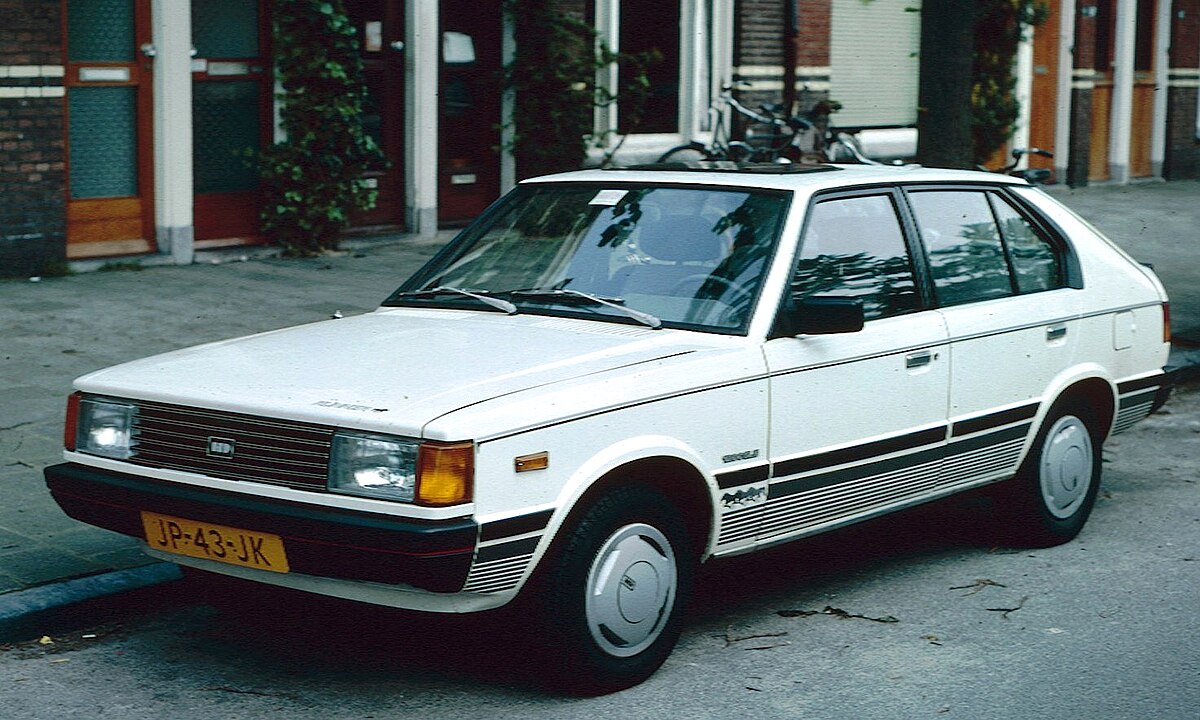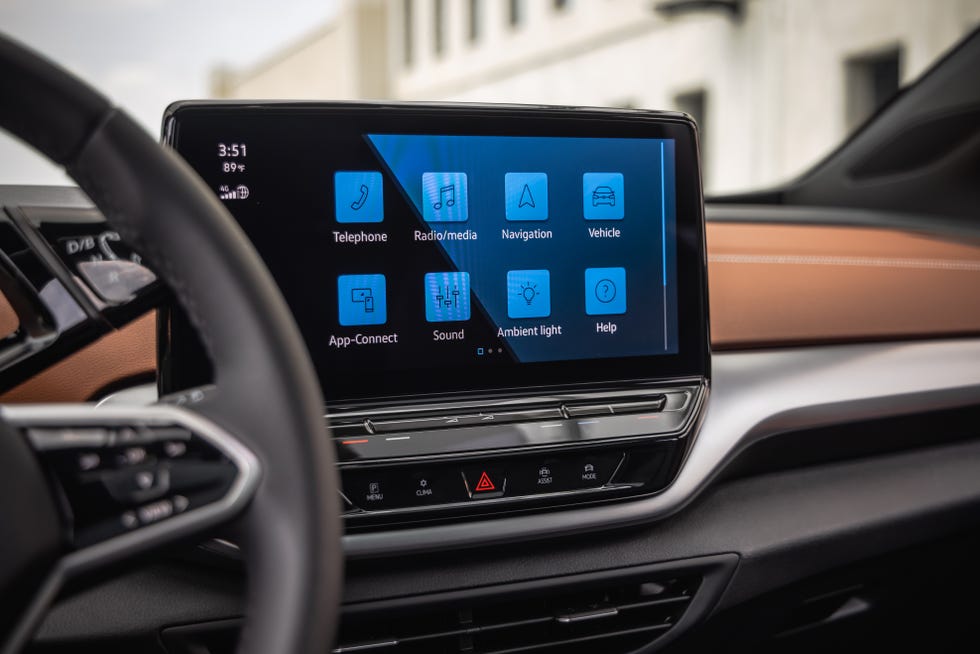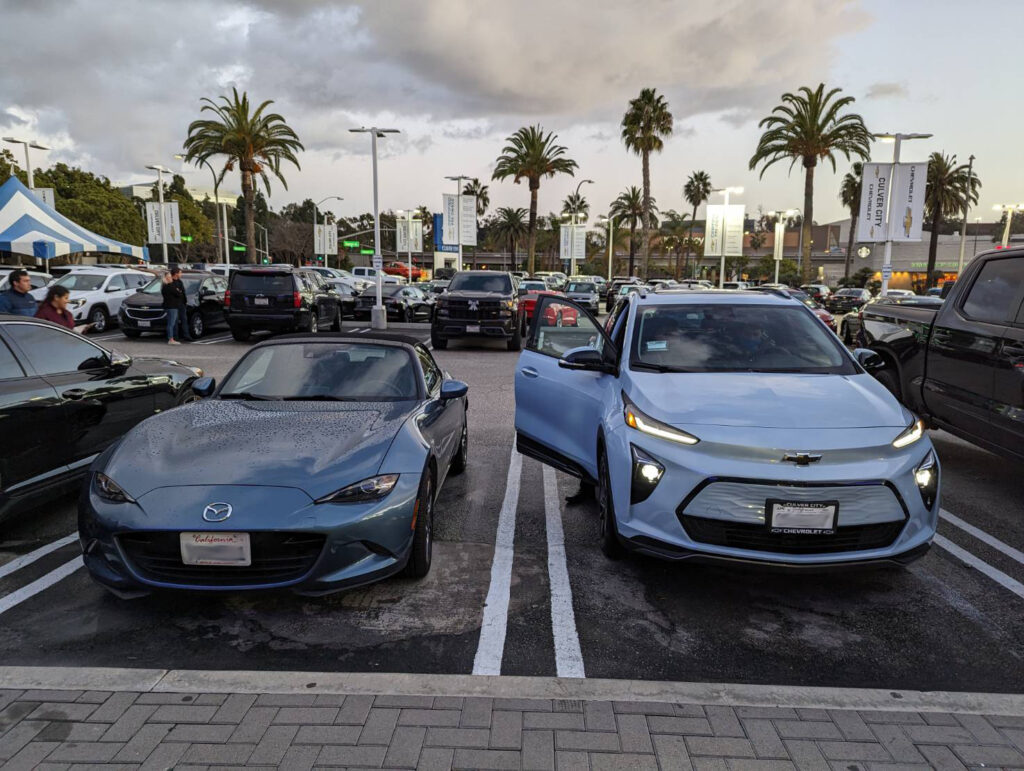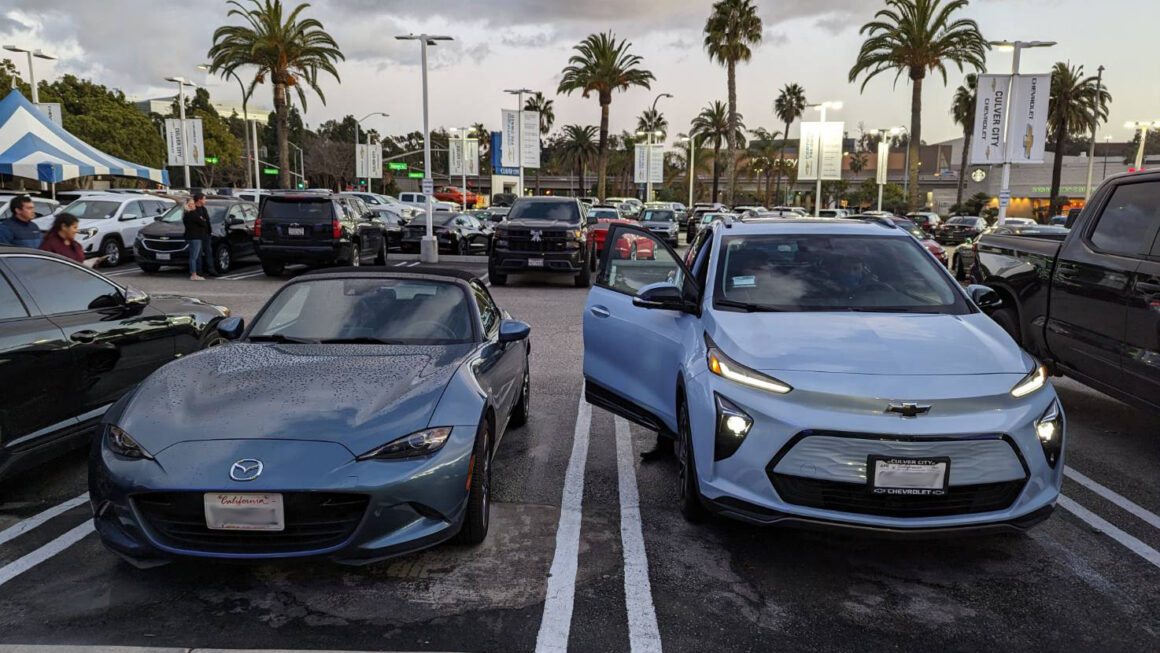Like all middle-aged folk, I only half expected flying cars to arrive by now, but I fully expected electric cars to be available by now.
In 2016 our household had to purchase new cars (plural because working from home permanently wasn’t a thing yet) and at that time the only all-electric (now called BEV) option was an expensive Tesla or a very limited range Leaf. The “cheaper” model 3 was still a year away. The time for our electrification would have to be postponed for the next household automotive turnover. With my Mazda 3 sold in 2020 (when permanent work from home did become a thing) and her Miata hanging around on a 7 year extended warranty we had a deadline of fall 2023 to get buzzing. But, more than a few broken bones and a long recovery time can do a lot to motivate the procurement of a more comfortable ride. A Miata is extremely reliable, but it’s also a reliably rough ride, to say nothing of the difficulties just getting in and out of a seat mere inches off the ground with only one pressure-capable arm and ribs that zing with every twist of the torso. “Feeling the road” is a bug, not a feature, when you’ve got broken ribs.
So the existing tabs I’d been keeping on the electric car market went into overdrive last summer. We first began test driving in July when Sam got her cast off and could drive again wearing a brace. At that time we discovered that actual drivable EVs on car lots were few and far between. In fact, we were only able to drive an Ioniq 5, the only one on the lot and already reserved unless we immediately ponied up even more money than the $60,000 already on it. We were informed that us driving it was a “favor” and to “not tell the manager,” etc.
Now this is where I’ll start elucidating on why we took certain cars out of contention. Any of my friends reading this who did pick up those cars and are tempted to be offended please don’t be. All EVs are great as EVs, and we’re glad you like your car, we just had a different checklist than you and I’m just going to describe that list.
Okay, with the disclaimer out of the way I can reveal I did not like the interior of the Ioniq 5.

It felt like a kid’s toy but with the color removed. Think 1997 Pontiac Grand Am interior, rounded off plastics, but with a couple sideways cell phones glued to the top. Even the wheel has the frowny face plastic spokes and missing brand logo centerpiece from the Grand Am! The capacitive climate/radio switchable controls was an interesting idea, but became confusing when in use. Just put controls for both down there so I don’t have to squint and prod while I’m moving. (this experience would also shape my opinion of other EVs having those functions even further locked away behind screen-based menus like in the Mach-E and Teslas) I did like the green exterior color, but the hard angles on the outside were too garish for me up close. The photos show a car based on the old Pony, but the real deal is an SUV in the shape of a VW Golf, too bloated to carry off the “cool street hot hatch” look it’s intended to portray.

Again, only MY subjective opinion, folks. Sam thought the interior was okay, but the exterior was not appealing. So that one was off the list even before we were priced out by market adjustments.
With nothing else drivable over the summer I started calling dealerships ahead of time and taking notes in an excel document. This lasted for months until around Halloween dealers wizened up and made sure they’d have a “test model” for folks to test drive on the lot. Except for Ford. Which, even deep into December, would let us do no more than sit inside a mach-e (and F-150 Lightning, though driving a freaking aircraft carrier around LA was never a serious option for us), but not even turn it on. We had a more illuminating experience regarding the Mach-e from a friend who took delivery in late summer and let us prod it a bit during a beach day. Probably would have let us test drive it, but (probably due to memories of doing so in teenage years to the ire of frustrated parents) I have a well defined fear of getting even so much as a door dent in someone else’s car. However, we needn’t drive it as Ford raised the price for the second model year, placing it out of our target range, especially with (you guessed it) horrendous market adjustments on unreserved dealer deliveries. Our friend had to place an order and wait about eight months to get their Mach-E.
So it was on to the rest. The KIA EV6 was nice enough inside, still a little too bulky and overstyled for me on the outside (much less than the Ioniq 5), but is still the fastest EV we test drove of the lot of them. You have to pay for that speed, and KIA learned quickly from Ford, promptly discontinuing their lower priced “Wind” tier for 2023 deliveries. Crazily this made the Wind models “rare” cars that could then command markups to make them almost as expensive as the higher tier Wave models. (Tulip, anyone?) The Glengarry Glen Ross sales floor experience of Glendale Kia also turned us off to the whole endeavor. Kia’s corporate focus is now higher technology upmarket offerings but their actual dealer experiences haven’t budged from the bargain basement “sell as many as you can, we have to make money on volume!” approach.
But there was a new KIA on trucks and already discoverable on YouTube. It came in cool colors and actually looked like the crossover it is, not a hatch on steroids. We’d just have to wait a few weeks to see lots begin deliveries of the cheaper EV – the redesigned KIA Niro EV. We were excited to test drive it. Until we did. It was a bit underwhelming. A cool green color on the exterior and not a badly designed car, but the interior looks infinitely better in YouTube videos than in real life.
(btw, I’m not going to do a paragraph on the Niro’s sister: the redesigned Hyundai Kona, because it had the cheapest interior of any 2023 model year car, EV or not, that we sat in)
For a car that still starts (in reality) over $40,000 having two cell-phone sized screens slapped inside a black plastic wedge seemed a bit pedestrian compared to other offerings. The screens themselves were extremely reflective and hard to see even in fall’s overcast sky on a test drive, we cringed imagining what a day trip to the beach in July might be like. With any kind of options applied the cars were blowing past $50,000 and for the time being qualified for no EV rebates what-so-ever being wholly manufactured in Korea.
Meanwhile we’d test driven the Bolt several times and knew the Niro had a starting price where the Bolt ended, but with less technology. Sam previously owned a 2012 Hyundai Sonata and it was painful to see the Niro stuck with the same decade-old backup camera, while the Chevy had “surround vision.”
So why didn’t we just go with the Bolt back in June? Well, in theory the Bolt is at the lowest quality end of the market for full size (200 miles) battery BEVs, at least until Stellantis dumps whatever failure they can cobble together with leftover parts on the American EV market (an electric charger that SOUNDS like an ICE charger is coming by 2025!!!!). Also, Ford has decided (for now) not to bother meeting the automotive needs of plebs, making its first BEV a “mustang” SUV instead of fully electrifying the existing much cheaper (and now discontinued) PHEV C-max (which we enjoyed driving in Colorado ten years ago). (fun fact: I almost bought a used C-Max instead of a new Mazda 3 in 2016 because the C-max was cheap and extremely fuel efficient)
(and the C-max came in green, are you seeing a pattern here?)
We were essentially resigned to waiting and looking for a non-chevrolet vehicle (or the new Ultium based ones) to provide a better mix of overall quality and efficiency. However, most of the cars on the lots (of all brands) had extreme markups of between five and ten thousand dollars (“market adjustment”) on the stickers that we balked at. Additionally the Bolts underwent an infamous battery recall that made them temporarily unavailable or on backorder. This caused even Bolts to temporarily have as much as $8,000 in market adjustments (looking at you, Community Chevrolet in Burbank) due to scarcity alone. Competitors that we assumed would be on the market experienced similar fates when the Toyobaru EV partnership paused in a stop-sale in 2022 due to….checks notes… the wheels falling off. You read that right, Toyota’s build quality has slipped so much in the past decade that they can’t even manage to keep wheels on the cars when you drive down the road! Fiat Chrysler must have been salivating at the opportunity to not come in dead last in dependability!
So we waited.
As time went on and cars stopped flying off the lots the salesmen would say “maybe I can get that market adjustment removed for you if you buy it today.” Part of this had to do with the IRA bill signed in August that savvy shoppers (but at first very few salesmen) knew would get some of the EVs a $3,750 tax credit in 2024 (for cars bought in 2023). We would inform them of this and make sure they knew we could wait.
Volkswagen entered the picture with a tester ID4 in Glendale. It had a nifty back massage feature in the drivers seat, seemed like a solid car, had nice styling inside and out, and would qualify for the $3,750 tax credit due to it’s being manufactured in Tennessee. But the price was peaking a little bit beyond the KIA. The build quality did seem better and the exterior looked fine, but the GUI for the car sank it. It’s the worst looking GUI of any car we drove showcasing a two color selection screen that looks like it’s built on a Linux box from 1992 (seriously, the icons are solid blue squares!) and a teeny tiny gauge cluster were not what we expected from a car that probably would have hit $55,000 by the time we were done with options.

The VW’s base range stood at 40 miles less than the Bolt, encouraging buyers to start off at a higher price point like KIA’s EV6. At least the Ford had the big gauge LCD and a fancy screen-knob thingie for that money. Tesla too, as $55,000 gets you a well-equipped longer range Model 3.
Speaking of Teslas, we ended up taking relatives to 3rd Street in early November and realized there was a Tesla dealership there with tester cars. The Burbank dealer, it turns out, has been converted to a service-only location and had zero test cars when we looked months earlier and Tesla’s customer support phone number never picked up when I called to see which locations had test drives. I’d given up earlier, but in November, there they were polished up in front of us (and a whole long line of them charging in the garage behind the showroom in every color available), so why not give it a spin?
At first, Sam loved the Model 3. The technology and the design makes an easily likable first impression on anybody. They do a very good job of making it easy to adapt to electrification with a lot of handholding (like planning out your route with chargers, etc.). However, I wasn’t sold on the “look over at the middle of the car to see how fast you’re going” idea. I also wasn’t a fan of having to go through screen menus to operate things like side mirrors. The ride experience, the design, and the overall feel were great, though. And we weren’t unaccustomed to it. We have friends that have owned every Tesla model (except the original Roadster) and so we’d spent some time in them, just not in the driver’s seat.
And when finally in that seat it was a bit underwhelming. The model three accelerates quickly, but all EVs do with instant torque. And unlike the Model S, the acceleration in a non-performance (not the 3.1 seconds to 60 dual motor) model three doesn’t pin you to your seat any more than any other base model BEV at 5.7 seconds to 60mph, the same figure as the AWD ID4 and only 1.3 seconds faster than the Bolt, Polestar 2. The Niro and Kona are even slower at 7.5 and 7.9 seconds.
Keep in mind we’re comparing the acceleration experience to a Miata, which, ironically, is the same 5.7 seconds as the base model Tesla.
In practice, though, I couldn’t discern any noticeable acceleration difference between any of these cars until getting in a Wave EV6 in sport mode which puts up the same times as the dual motor Model 3, and carries a similar skyrocketing price tag to justify it.
For a time it was down to the KIA Niro EV (we had to test drive it multiple times to decide the value just wasn’t there), the Model 3, and the Chevy Bolt (EV or EUV at first).
Then, stuck in traffic on the PCH one long November Sunday, we called our insurer. Okay, Chevy Bolt it is! To insure the Model 3 was going to cost an astounding $4,000 a year even on “esurance.” (and no, we don’t have a bunch of tickets or accidents or bad credit or anything) We shopped the rates around and found out that insurers typically don’t like Teslas because the replacement parts are more difficult to get (not as many “dealerships” to get the repairs through) and the starting price is higher so they have to pay out more when they’re totaled. To be fair Tesla has tried to get around this by offering its own insurance, but the other side of that coin is that allows them to raise the price on you by whatever they want whenever they want just like they do with the cars (as anyone who bought one in December before the 20% price reduction found out the hard way!).
At the time a similarly equipped Model three would have been the most expensive car we tested if it wasn’t for the markups. You could say Tesla “doesn’t do markups” but in reality they just markup the car for everyone on a schedule (or mark it down suddenly to generate sales, as folks found out in January!). But at least it’s not a surprise, you know the price online before you go to the dealer and there’s no 2023 iteration of “undercoating” involved.
By December it was probably going to be the Bolt. Tesla reached out to us with their year-end $7,000 off offer, making it competitive with the Chevy (except for the insurance), but by then Elon had begun his embarrassing self-own Twitter campaign which made us reluctant to fund his hostile take-overs of any other media outlets to Trumpet Qanon garbage. If any of the other car brand CEOs want folks to vote republican they at least didn’t spend $40,000,000,000 buying a bullhorn to announce it.
If you weren’t paying attention you probably think this is me reverting to talking politics on this blog again. But, no, he actually did it.
So yeah, I’ll not be giving this guy 50 grand if I can help it.
So the clock kept ticking toward the day when the Federal coffers would magically spill out more tax incentives. And along the way the government made things even more complicated. In late December the Treasury released a statement which, at first, was not picked up by many news outlets. Since I’d been tapped into this topic and closely following it (did you know there’s another bill in congress waiting to be voted on that would suspend the US manufacturing provisions of the bill for several years, sponsored of course by politicians from Alabama, which just happens to have a Hyundai plant?) my ears perked up and through some searching (most articles did not actually contain a link or cite the announcement) I found the actual Treasury announcement, buried under a bunch of other press releases from the same time period.
Anyway, the announcement contained a HUGE shocking piece of information that would result in potentially thousands of dollars of savings for those that knew the details and could act fast. In summary, the treasury announced that it could not comply with the IRA’s language of specifying which vehicles met which parts of the battery materials manufacturing rules by December 31st, 2022. The average person might say “so what?” Well, by law that means THAT section of the bill is unenforceable until the guidance is released. The Treasury said the guidance would arrive in March at the earliest. Did you catch that?
Translation: For cars with final assembly in the United States, on January 1st 2023, subject to other provisions for consumer qualifications such as taxable income, the full $7,500 EV credit would be available until the end of February (or whenever the Treasury releases final battery component guidance after that date).
At first the dealers had no idea. We tried to put a deposit on a Bolt the last week of December so we could pick it up in January. You see, the bill’s language states that the important date is when the car is “placed in service,” meaning when the consumer actually takes it home.
Add into this picture, to make things extra spicy, Costco (of which we’re members) had a $500 off Bolt MSRP special with select Chevrolet dealers that would expire on January 3rd. So if you’re following, that means a Bolt could be had for $8,000 “off” (before any state-specific EV rebates and programs) if bought within the first three days of January.
However, as we found out in the final hours of 2022 dealers were slowly catching on. The information was being translated and leaking out into the real world with auto-blog headlines like “The Bolt will be a Screamin’ Deal in January!” As a result most of the dealers we’d previously been talking to, like Allen Gwynn in Glendale, that had no markups, suddenly reported markups starting January 1st of $5-$10,000. Thus trying to claw back the new rebate into their own pockets (I can hear my father screaming his conservative economics take on the situation and how this proves the government shouldn’t use tax incentives to change consumer behavior!).
However, not all dealers were doing this. And some dealerships were even open on New Year’s Day to get the jump on others that were not. Online message boards like Reddit exploded with buyers sharing who was marking up and where and how much. This led me to a Chevrolet dealer in Fontana, about an hour away, which assured me over the phone that they would be open and selling at MSRP on New Year’s Day. They also happened to have the exact model we wanted with color and options. We made an appointment for 9:30am.
At 9:30am all the Bolts were sold. We were told there was a line of 15 buyers waiting outside the door at 9am for the 8 cars that were on the lot. I guess we weren’t the only buyers that were aware of the special discount situation (and didn’t want to pay a markup). The dealer offered to take an order for us, but without being able to guarantee if it would arrive in time for the full tax credit we decided to pass.
On the drive back home Sam started calling around to other dealers between Fontana and Glendale that were open. One of which was in Pasadena and said they still had several bolts. When we arrived there were several folks there to see the Bolts. So many that they were out of salespeople and we were directed to look at the cars by someone who stated emphatically he was NOT a salesperson, without defining what role he did have. After getting to the cars he informed us that there was a nonnegotiable $5,000 mark up on all Bolts.
We left a bit dejected, but still hopeful, because it was clear that unlike at Fontana (where there were no markups) the Bolts with markups were NOT already sold out yet. That means more folks like us were balking and walking away from the markups. So we’d probably just have to wait a bit longer. We thought this would mean days or weeks. We meandered around the area, stopping somewhere to look at plates and pots and pans at home goods before going home for lunch.
While making lunch I received a text from a dealer that had previously assured me they didn’t do markups, but that would end in 2023. The text was:
“Happy New Year Andrew! Culver City Chevrolet has very exciting news. It was just announced for a very limited time Chevy Bolt will be eligible for up to a $7,500 Federal Tax Credit! And even better news – we have 35 Bolts in stock RIGHT NOW! Click to claim yours before they’re gone. We expect to sell out this week!”
I clicked the link and saw there was in inventory one Bolt that matched our exact specifications. So I called, but I girded my expectations.
“Are you doing markups?”
“No.”
“Okay, we’re on our way!”
About 40 minutes later we pulled up to the dealership to see our model parked right in front. We parked right beside it and one of the sales people came up to help us. We noticed other Bolts sitting around. And nobody looking at them. And sales people bored, not overwhelmed by demand. So, as quickly as the EV credit twist elevated demand in one day, it had dissipated enough in a few hours for dealers to begin making sales calls (or, in my case, texts) to existing interested parties.
We looked at the window though and saw the dreaded “market adjustment.” $5,000. We were livid that we’d been lied to on the phone to drag us down there. The salesman asked who told us there were no markups. Once we said the name something clicked in his mind and he said “oh, okay, then there’s no markup for you.”
We took a quick test drive just to make sure it’s not a Toyota-style BEV with the wheels were falling off, and then went inside to make a deal.
And that’s when the undercoating came in.
Now it’s worth noting that EVERY dealer for EVERY brand of EV had placed some sort of dealer add-on to the car to claw back more money even if they listed the cars at MSRP with no market adjustments. Many tried to explain this as a selling point that “Hey, at least we add SOMETHING to the car for the extra money!”
In our case it was $3,000 for “SWAT” (a GPS tracking stolen car recovery beacon) and “paint protection” (little plastic covers on the door edges).
Ultimately we were able to knock down the price on those add-ons and increase the price of our trade-in (we came armed with a Carvana offer that we forced them to match) until we felt comfortable with the price. I said “we” but it was really my wife’s master bartering skills that got the job done.
“We need to knock down those add-ons, guys”
And then they tried to “ice the kicker” by making us wait a bit.
“The best we can do for you guys is knock $500 off that.”
“You could remove the whole thing if you wanted, it’s your car and your add-on.”
“My manager already approved the $500 discount for you guys, he can’t do better than that.”
“He can if he wants to sell this car to us right now. Go back and change it to $1,000 and add $1,000 to the trade-in too.”
Another strategic delay…. And then he came back and said “okay deal.”
I know some of you that negotiate cars might be screaming “you guys are dumb, you should have had them remove the WHOLE THING!” But keep in mind these care were (and still are) in a high demand low supply situation. That and the smorgasbord of credits and sales and so on would not be guaranteed at a later date. There would be more buyers arriving for this car soon, it had only been on the lot 9 days, and this was the first day it would qualify for a $7,500 tax credit.
The Costco discount would end in 2 days. There were also rumors that Chevrolet would be enacting MSRP price increases in 2023 but since most dealers were closed on the 1st they’d send notice in a few days. In fact, these increases did happen a few days later and amounted to about $900 more on new Bolts, even those already ordered last year but not yet delivered! So, we essentially negotiated to bring the add-ons down to match the amount the price would have gone up naturally in a day or two without Costco discount and with the Chevy price increase.
And then there was the EVGO offer. At that time, and it could have ended (but I don’t think it has yet), there was a further discount from Chevy of $1,000 towards the installation of a charge point in your home or $500 in EVGO credits. What I didn’t tell you yet is that our new home already had a NEMA outlet installed by the previous owner for their Tesla. Another selling point for the Bolt is that it comes with it’s own EVSE connector to plug directly into a 240 or 120 volt outlet. So if we bought before that promotion ended we’d get the $500 in charging credits since we already had an outlet. With certain other BEVs you don’t get any of those things and setting them up after purchase can cost thousands depending on your home’s electricity set-up (we knew our panel was set up for 200 amps so we’d be able to charge at the regular rate with the EVSE and NEMA outlet).
Okay, so we’ve done our negotiating and we’re pinching ourselves that we’re actually going to get this thing and it’s not gonna be a huge markup and we made it in time for all these deals and discounts and what-have-you. Into the finance office we go. Why finance? Because all the banks are closed on January 1st.
So another part of this long process was figuring out how to pay for the dang thing. We learned that dealerships stopped taking credit cards for the entire purchase years ago (but more recently than the last time we did it!). Instead, they wanted a cashier’s check or finance the rest of the amount after a $5,000 down payment limit on credit. A regular check could be accepted, but not to drive the car off the lot, the check would have to clear first. Knowing this ahead of time we decided to just finance (after paying what we could on a credit card) and immediately pay off the loan. This would result in a finance charge of some kind but we’d happily eat that to have the flexibility to just walk away from the dealerships if necessary (which we’d done twice that day already!).
The financing experience has changed since 2016. Dealerships now have a low rent version of MS Surface that’s intended just for signing documents. So the pages now come up on a screen and you sign with a digital pen. We asked to read the financing contract to see if there was a pre-payment penalty. When we couldn’t find these details the finance officer said “that’s it – the pages you see on the screen are all there is.” This seemed odd, but okay. The finance officer also wrote in a $5,000 credit card payment instead of the $10,000 credit card down payment we’d written in on the negotiating page with the salesman. This caused the whole process to stop so he could verify it and then start over again, signing all the papers again and so on. But it was worth it because even though we have perfect credit, the GM Financial financing rate was an astounding 7.99% that day. But the APR doesn’t matter much if you’re paying it off before the first payment is due, right?
After we completed the signing he printed everything out, folded it up, put it in an envelope, handed the envelope to us and whisked us outside to start transferring our personal items out of the Miata we no longer owned.

Hours later, back at home, we unfolded the purchase contract and (surprise!) there were more pages than what he showed us on the screen. And there was, in fact, a prepayment penalty. Both the finance officer and the salesman had rolled their eyes at our questions about whether this would be the case. But there it was. A small amount, thankfully, but it existed. He’d lied, not shown it to us, then packed the actual printout up and hoped we’d be too dumb to say “wait, I want to make sure what you just printed is the same as what you just showed us on the screen because car dealers are all sleazeballs!”
We also found out days later that the EVGO program manager at the dealership either lied or didn’t know the real answer when he said the charging credits “never expire.” It turns out they expire three years after the date of purchase. Good to know sooner than later.
Other than those two sour points the experience wasn’t that onerous. It wasn’t fun, of course, and there were a few moments where I was glad to be married to a master barterer, but we were in and out of there in only a few hours.
Only after bringing the car home did we check into California EV rebates. We assumed they’d run out or we wouldn’t meet the income requirements (which are much stricter than Federal). However, after more research it turned out we could apply for them both because of how income is calculated and when you submit the application (relative to tax filings and the amount of EV rebate funds left in the general account). After finding the right place online to do this the application process turned out to be very easy. And we were approved an hour after submitting. A few days later we received an email with a scan of the check notifying us it was going in the mail. A week later it was in our hands. We’ll have to wait until tax season next year to see any of the $7,500 Federal tax credits we so carefully timed this to get, but it felt very good to get some of that money back right away, before we’d even spent a dime on the car. So if you’re keeping track we got a combined $10,500 of specials, rebates, credits, and discounts on this car because of a lot of careful attention to details, timing, and a lot of work keeping tabs on inventory at every Chevrolet dealer within 100 miles.
I’m finishing this blog post up in late January. Because my mother-in-law is staying with us we have been driving the car more on the weekends than we probably usually would. So we’ve put over 200 miles on it already, but that means we’ve gotten more familiar with it. There are some good surprises and some bad. It’s still a “screamin’ deal” so we’re happy with the purchase, but we slowly figured out where Chevrolet cut costs to make it happen. Keep in mind we got a “Premium” with everything except SuperCruise, so if something’s missing – it’s really missing.
| Good things about the Bolt | Bad things about the Bolt |
| Includes 120 and 240 volt charging cords | No homelink garage door opener |
| Android Auto | The constant push to get Onstar for $15/month |
| Adaptive Cruise control + lane assist + front collision warning/braking is so good already I don’t feel we need SuperCruise. | The Chevy app does nothing without Onstar. The car has the info and has wifi, but Chevy wants $15/month just to show state of charge in the app |
| Range on moderate days in moderate climate is amazing (we’re seeing our max range hover near 300 miles on 90% charge) | There is no trunk/hatch release button on the fob or in the car, already got my sister-in-law soaked in the rain assuming otherwise |
| Regen seems to be most aggressive of any BEV | older Battery architecture, 2nd oldest on market after Leaf |
| tires are self-healing and pressure can be monitored on the dash in real time | Chevy’s EV concierge could not answer questions that weren’t already included in the manual or online FAQs |
| one-pedal driving is so much easier | Neither dealer nor EVGO told us we could sell our $500 credit before we loaded it on our account. |
| Miata’s size makes you an extremely defensive driver, but Bolt allows you to relax, which makes the trip feel much faster | The onboard voice command is not very accurate, maybe worse than Mazda or Hyundai; “go home” is not a command that should confuse a car… |
| we are averaging 4.5 miles per Kwh (better than most BEVs) | To get an actual state of charge % while charging you have to open the door |
| It’s not a giant boat, like a lot of SUV BEVs, it’s only 3″ wider than a Miata despite being 2′ longer! | the computery bits and wires under the dash are just….open… unlike other cars that at least cover this up with cheap plastic |
| Surround Vision is amazing (especially coming from a car with NO backup camera)! | interior fit and finish is more low quality in places than expected for a $40k car |
| digital rear-view mirror is great at night or when people in back seat are blocking view | The state of charge indicator is a series of blinks, like morse code, instead of just having a series of lights that light up as the battery fills up… |
| heated and ventilated front seats | family/friends that think “it’s gonna catch on fire!” |
| my wife loves it | Extremely slow “fast” charging (not a road trip vehicle) |
| automatic headlights that just…work | automatic rain sensing wipers that really…don’t |
| With LADWP pricing it’ll cost about $12 to go 280 miles |


